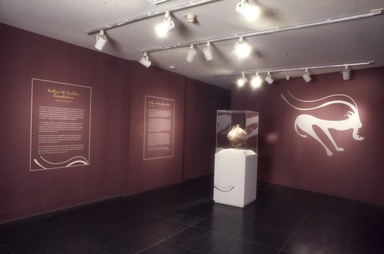

Wit & Wine: A New Look at Ancient Iranian Ceramics from the Arthur M. Sackler Foundation, September 07, 2001 through December 30, 2001 (Image: ECA_E_2001_Wit_Wine_001_SL5.jpg Brooklyn Museum photograph, 2001)
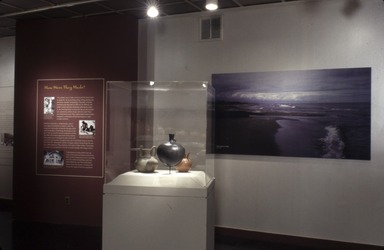
Wit & Wine: A New Look at Ancient Iranian Ceramics from the Arthur M. Sackler Foundation, September 07, 2001 through December 30, 2001 (Image: ECA_E_2001_Wit_Wine_002_SL5.jpg Brooklyn Museum photograph, 2001)
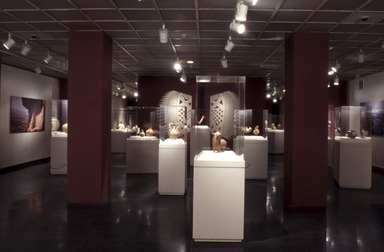
Wit & Wine: A New Look at Ancient Iranian Ceramics from the Arthur M. Sackler Foundation, September 07, 2001 through December 30, 2001 (Image: ECA_E_2001_Wit_Wine_003_SL5.jpg Brooklyn Museum photograph, 2001)
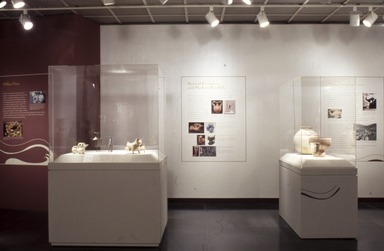
Wit & Wine: A New Look at Ancient Iranian Ceramics from the Arthur M. Sackler Foundation, September 07, 2001 through December 30, 2001 (Image: ECA_E_2001_Wit_Wine_004_SL5.jpg Brooklyn Museum photograph, 2001)

Wit & Wine: A New Look at Ancient Iranian Ceramics from the Arthur M. Sackler Foundation, September 07, 2001 through December 30, 2001 (Image: ECA_E_2001_Wit_Wine_005_SL5.jpg Brooklyn Museum photograph, 2001)

Wit & Wine: A New Look at Ancient Iranian Ceramics from the Arthur M. Sackler Foundation, September 07, 2001 through December 30, 2001 (Image: ECA_E_2001_Wit_Wine_006_SL5.jpg Brooklyn Museum photograph, 2001)

Wit & Wine: A New Look at Ancient Iranian Ceramics from the Arthur M. Sackler Foundation, September 07, 2001 through December 30, 2001 (Image: ECA_E_2001_Wit_Wine_007_SL5.jpg Brooklyn Museum photograph, 2001)
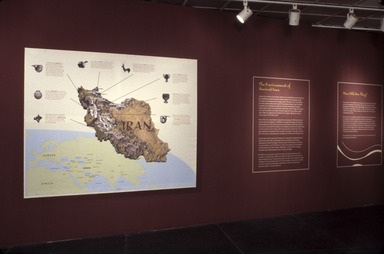
Wit & Wine: A New Look at Ancient Iranian Ceramics from the Arthur M. Sackler Foundation, September 07, 2001 through December 30, 2001 (Image: ECA_E_2001_Wit_Wine_008_SL5.jpg Brooklyn Museum photograph, 2001)

Wit & Wine: A New Look at Ancient Iranian Ceramics from the Arthur M. Sackler Foundation, September 07, 2001 through December 30, 2001 (Image: ECA_E_2001_Wit_Wine_009_SL5.jpg Brooklyn Museum photograph, 2001)
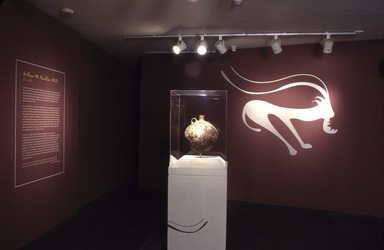
Wit & Wine: A New Look at Ancient Iranian Ceramics from the Arthur M. Sackler Foundation, September 07, 2001 through December 30, 2001 (Image: ECA_E_2001_Wit_Wine_010_SL5.jpg Brooklyn Museum photograph, 2001)
Wit & Wine: A New Look at Ancient Iranian Ceramics from the Arthur M. Sackler Foundation
-
April 7, 2001
Wit & Wine: A New Look at Ancient Iranian Ceramics from the Arthur M. Sackler Foundation, on view at the Brooklyn Museum of Art September 7–December 30, 2001 is the first major exhibition of ancient Iranian ceramics in over a decade. The exhibition features forty-five extraordinary pieces that illustrate the 5,000-year ceramic tradition that flourished in ancient, pre-Islamic, Iran until 100 B.C.E.
The beautiful, technically sophisticated, and often amusing ceramics of ancient Iran demonstrate a rich yet little known tradition comparable to pre-Columbian, Chinese, and Greek achievements, establishing ancient Iranian pottery as one of the great ceramic traditions.
The jugs, jars, beakers, and spouted and shaped vessels in the exhibition were used for holding, pouring, and drinking liquids, especially wine. Wit & Wine explores how ancient Iranian potters made and decorated these vessels with high quality craftsmanship and design, often with a unique sense of humor. Many pieces are shaped like animals or are painted with animal motifs. Interpretations of wild and domesticated animals show elegant deer, powerful rams[,] and amusing goats. Some pieces were created to serve specific functions such as cosmetic containers, some vessels were made to look like metal, and others are purely sculptural forms.
Included in the exhibition are an extraordinary ceramic head and neck of a bull, a vessel in the form of a seated camel, a rhyton (drinking horn) with a goat head handle, a vessel with a deer’s head spout, a vessel in the form of a stag, a spouted vessel in the shape of a bull, and a delightful vessel with two feet. Also on view will be a beaker painted with goats, a jug with four rams’ heads, a vessel in the form of a mysterious aquatic animal, a small rectangular bottle on a two-headed horse and a bull-shaped vessel with wheels.
Curators of the exhibition are Dr. Trudy S. Kawami, Director of Research for the Arthur M. Sackler Foundation, and Dr. James F. Romano, Curator of Egyptian, Classical and Ancient Middle Eastern Art at the Brooklyn Museum of Art.
The exhibition is organized by the Arthur M. Sackler Foundation of New York. Arthur M. Sackler, M.D. (1913–1987), a research psychiatrist, medical publisher, connoisseur, and collector of art, established the Arthur M. Sackler Foundation in 1965 to make his extensive art collections accessible to the public. The Foundation collection has more than 900 works of art including Chinese ritual bronzes and ceramics, Buddhist stone sculpture, and the renowned Chu Silk Manuscript, the oldest existing Chinese written document.
View Original -
June 1, 2001
Continuing Exhibitions
Arts of Africa
Long-Term Installation
Leon Golub: Paintings, 1950–2000
Through August 19, 2001
Digital: Printmaking Now
June 22-September 2, 2001
Upcoming Exhibitions
My Reality: Contemporary Art and the Culture of Japanese Animation
July 28-October 7, 2001
American Identities: A Reinterpretation of American Art at the BMA
Opens September 5, 2001 (Long-Term Installation)
Wit and Wine: A New Look at Ancient Iranian Ceramics from the Arthur M. Sackler Foundation
September 7-December 30, 2001
Vital Forms: American Art and Design in the Atomic Age, 1940–1960
October 12, 2001-January 6, 2002
Eternal Egypt: Masterworks of Ancient Art from The British Museum
November 23, 2001-February 24, 2002
Star Wars: The Magic of Myth
April 5-July, 7 2002
Exposed: The Victorian Nude
September 2, 2002-January 5, 2003
The Last Expression: Art from Auschwitz
February 28-May 11, 2003
Great Expectations: John Singer Sargent Painting Children
September 19-November 30, 2003
Continuing Exhibitions
Arts of Africa
Long-Term Installation
(African Galleries, 1st floor)
More than twenty important objects, previously not on view, will be integrated into a major reinstallation of some 225 works from the Museum's exceptional holdings of African art. Although a wide selection from the hundreds of African cultures will be represented, the reinstallation is exceptionally strong in works from Central Africa, particularly those from the Kongo, Luba, and Kuba peoples of the Democratic Republic of the Congo. The majority of the items on display were created for religious or political ceremonial life, but the presentation will also include furniture, textiles, architectural fragments, household items, and objects of personal adornment.
Organization: The reinstallation has been organized by William C. Siegmann, Chair of the Department of the Arts of Africa and the Pacific Islands at the Brooklyn Museum of Art.
Leon Golub: Paintings, 1950-2000
Through August 19, 2001
(European Painting and Sculpture Galleries, 5th floor)
This exhibition examines the career of Leon Golub (b. 1922), dean of American political art, whose intense, gritty paintings examine the complexities of power. The artist's raw and expressive canvases span the second half of the twentieth century and explore issues of race, violence, war, and the human condition. The exhibition of some fifty-five works, many of which are mural-sized, includes such monumental paintings as Gigantomachy Il (1966), Vietnam II (1973), and the BMA's own Riot IV (1983). A selection of Golub's lesser-known political portraits and his recent paintings that consider mortality will also be included.
Organization: Leon Golub: Paintings, 1950-2000 was curated by Jon Bird, an independent, London-based curator, and organized by the Irish Museum of Modern Art in Dublin. Brooke Kamin Rapaport, Associate Curator in the Department of Contemporary Art, organized the presentation at the BMA.
Support: The BMA presentation is supported, in part, by the BMA's Barbara and Richard Debs Exhibition Fund. Additional support is provided by The Broad Art Foundation and Dr. and Mrs. Philip J. Kozinn. Educational activities are made possible by the Third Millennium Foundation.
Publication: Leon Golub: Echoes of the Real, with an essay by Jon Bird, includes more than 130 color plates and is published by Reaktion Books, Ltd., London.
Digital: Printmaking Now
June 22-September 2, 2001
(Morris A. and Meyer Schapiro Wing, 4th floor)
This installment of the Print National, a survey of important developments in the field of printmaking, will focus on the increasing use of computers in the printmaking process. The exhibition, one of the first to address this issue, will include traditionally printed works that have been manipulated digitally and works created entirely by computer.
Organization: This exhibition was organized by Marilyn Kushner, Curator of Prints and Drawings at the Brooklyn Museum of Art. Support: Digital: Printmaking Now is organized by the Brooklyn Museum of Art. The exhibition is made possible, in part, by the Lily Auchincloss Foundation, Inc., and the BMA's Prints and Photographs Council. Additional support is provided by Marc A. Schwartz, Seymour and Laura Schweber, and Philip and Alma Kalb, and The Fund—created by a gift from the Elizabeth Firestone Graham Foundation. Educational activities are supported by the Third Millennium Foundation. Media sponsors are Artbyte Magazine and Art on Paper.
Publication: A fully-illustrated color catalogue will be available.
Upcoming Exhibitions
My Reality: Contemporary Art and the Culture of Japanese Animation
July 28-October 7, 2001
Synergies between Japanese and American popular culture are explored in this showcase of photography, painting, sculpture, and video that investigates the influence of Japanese animation (anime) and techno-culture on art. Anime is incredibly versatile in its ability to comment on social and sexual mores, gender roles, and traditional values in the face of an increasingly alien future. The exhibition features work by Takashi Murakami, Mariko Mori, Paul McCarthy, and Charlie White, among others.
Organization: My Reality: Contemporary Art and the Culture of Japanese Animation was originally curated by Jeff Fleming, Senior Curator, and Susan Lubowsky Talbott, Director of the Des Moines Art Center. The exhibition is coordinated at the Brooklyn Museum of Art by Charlotta Kotik, Department Chair of Contemporary Art.
Support: Educational activities for the BMA's presentation are supported by the Third Millennium Foundation. Additional support provided by The Fund—created by a gift from the Elizabeth Firestone Graham Foundation.
Publication: An illustrated catalogue co-published by the Des Moines Art Center and Independent Curators International accompanies My Reality.
American Identities: A Reinterpretation of American Art at the BMA
September 5, 2001-Long Term
(Luce Center for American Art, 5th floor)
This reinstallation of approximately 350 works from the permanent collections will present an innovative thematic survey of American paintings, sculpture, and decorative arts from the early eighteenth century to the present. An orientation gallery will introduce the visitor to the scope of the collections, showcasing a number of icons in a Brooklyn context. The galleries will be organized in a general chronological fashion with richly interpreted installations devoted to such themes as Dutch New Yorkers, Shaping American Landscapes, The Civil War Era, Women's Worlds, Urban Experiences, and The Drive toward Abstraction.
Organization: This project is a collaboration among curators of American Paintings and Sculpture: Teresa A. Carbone, Project Director; Linda S. Ferber and Barbara Dayer Gallati; Decorative Arts: Kevin L. Stayton, Chair of Department of Decorative Arts, Barry R. Harwood; Contemporary Art: Charlotta Kotik; Arts of Americas: Susan Kennedy Zeller
Support: American Identities: A Reinterpretation of American Art at the BMA is supported by a generous grant from the Independence Community Foundation for the Museum's project American Identities: Building Audiences for the Future, and by the National Endowment for the Arts.
Wit and Wine: A New Look at Ancient Iranian Ceramics from the Arthur M. Sackler Foundation
September 7-December 30, 2001
(Robert E. Blum Gallery, 1st floor)
This exhibition comprises forty-five pottery vessels—most for holding or pouring wine—from ancient Iran, ranging in date from the fifth millennium B.C. to the third century A.D. Demonstrating the extraordinary range of Iranian pottery, the exhibition includes such whimsical examples as a juglike vessel in the shape of human feet, and sculptural works in the shape of camels and bulls. Some containers clearly imitate early metal prototypes, with their unusually thin walls and long spouts, while others are painted with sophisticated ornamental designs depicting the animals of the Iranian highland. The Brooklyn Museum of Art is the last scheduled venue for this traveling exhibition.
Organization: The exhibition has been organized by the Arthur M. Sackler Foundation and curated by Dr. Trudy S. Kawami. James F. Romano, Curator of Egyptian, Classical, and Ancient Middle Eastern Art at the BMA, will organize the presentation at the Brooklyn Museum of Art.
Vital Forms: American Art and Design in the Atomic Age, 1940-1960
October 5, 2001-January 6, 2002
(Grand Lobby, 1st floor; Morris A. and Meyer Schapiro Wing, 4th floor)
This interdisciplinary exhibition will present 250 of the most innovative works of the 1940s and 1950s that embraced a vocabulary of organic, or vital, forms. Through architecture, decorative and industrial arts, graphic design, painting, photography, and sculpture, Vital Forms will examine the use of nature-based imagery during the postwar era. The exhibition will show how this aesthetic development represented an affirmation of life in the face of the Cold War and at the dawn of the nuclear age. Exploring the organic visual language adopted by some of the era's most progressive creators, the exhibition will include works of art and design such as paintings by Willem de Kooning and Mark Rothko, the "Predicta" television set, images of Eero Saarinen's TWA Terminal at JFK International Airport, Tupperware, the "Slinky," and the Ford Thunderbird. Additionally, the exhibition will trace how that visual vocabulary was applied to objects of popular culture, such as Formica countertop laminate and paperback book covers. The exhibition is the third in a series organized by the BMA that began with The American Renaissance, 1876-1917 (1979) and continued with The Machine Age in America, 1918-1941 (1986).
Organization: This exhibition will be organized by Brooke Kamin Rapaport, Associate Curator of Contemporary Art, and Kevin Stayton, Department Head and Curator of Decorative Arts at the Brooklyn Museum of Art. Martin Filler and Mildred Friedman are consulting co-curators, and Dr. Paul Boyer is the project's cultural historian.
Publication: A full-color catalogue published by the Brooklyn Museum of Art and Harry N. Abrams, Inc., will accompany the exhibition.
Tour:
Brooklyn Museum of Art:
October 12, 2001-January 6, 2002
Walker Art Center:
February 16-May 12, 2002
Frist Center for the Visual Arts:
June 21-September 15, 2002
Los Angeles County Museum of Art:
November 17, 2002-February 23, 2003
Phoenix Art Museum:
April 4-June 29, 2003
Support: Vital Forms: American Art and Design in the Atomic Age, 1940-1960 was organized by the Brooklyn Museum of Art. The exhibition was made possible, in part, by generous grants from the National Endowment for the Humanities and the National Endowment for the Arts. Additional support was provided by the Mary Jean and Frank P. Smeal Foundation, The Samuel I. Newhouse Foundation, and the Gramercy Park Foundation. Support for the catalogue was provided through the generosity of Furthermore, the Publication Program of the J.M. Kaplan Fund, as well as a BMA publications endowment created by the Iris and B. Gerald Cantor Foundation and the Andrew W. Mellon Foundation.
Eternal Egypt: Masterworks of Ancient Art from The British Museum
November 23, 2001-February 24, 2002
(Beatrice and Samuel A. Seaver Gallery, 5th floor)
This exhibition will provide a unique opportunity to view more than 140 ancient Egyptian masterpieces from The British Museum in London, many of which have never before traveled to the United States. Many large-scale works will be presented, including the capital of a temple column with a monumental carving of the goddess Hathor, as well as a world-famous portrait statue of the great pharaoh Sesostris III, royal jewelry, and paintings on papyrus illustrating scenes from The Book of the Dead. The exhibition will span the entire pharaonic period, from Dynasty I (about 3100 B.C.) to the period of Roman rule (4th century A.D.).
Organization: This exhibition was organized by the American Federation of Arts and the British Museum, with guest curator Edna R. Russmann, Curator of Egyptian, Classical, and Ancient Middle Eastern Art at the Brooklyn Museum of Art, and W. V. Davies, the British Museum's Keeper of Egyptian Antiquities.
Support: This exhibition and its national tour are made possible by Ford Motor Company. The official hotel of the Brooklyn leg of exhibition is the New York Marriott Brooklyn. Promotional support for the BMA's presentation is provided by Bloomingdale's. Additional support has been provided by the Benefactors Circle of the AFA.
Publication: A fully illustrated catalogue accompanies this exhibition.
Star Wars: The Magic of Myth
April 5-July 7, 2002
(Morris A. and Meyer Schapiro Wing, 4th & 5th floors)
The exhibition showcases original artwork, props, models, costumes, and characters used to create the original Star Wars trilogy—Star Wars: A New Hope, The Empire Strikes Back, and Return of the Jedi—as well as Episode I: The Phantom Menace. Included will be over 30 mannequins, 35 models, and 50 pieces of framed artworks. Among them will be R2-D2, C-3P0, Darth Vader, Yoda, Boba Fett, and Yoda as well as Princess Leia's Slave Girl Costume, Han Solo frozen in carbonite, the Millennium Falcon, and one of Queen Amidala's royal gowns. Interpretive panels throughout the exhibition trace the mythological and literary sources that transform Star Wars into a timeless epic. Drawing upon the work of Joseph Campbell in his book The Hero with a Thousand Faces, the exhibition shows how the themes of the young hero, the faithful companions, the endangered maiden, the wise guide, and others resonate through the Star Wars saga and give it an enduring universality. The exhibition will include a 26-minute documentary film, which will play continuously, on the making of the Star Wars saga.
Organization: Star Wars: The Magic of Myth was developed by the Smithsonian's National Air and Space Museum. The exhibition was organized for travel by the Smithsonian Institution Traveling Exhibition Service (SITES). All artifacts in this exhibition are on loan from the archives of Lucasfilm Ltd. The Brooklyn Museum of Art will be the final stop of a national tour. Catalogue: An illustrated catalogue accompanies the exhibition, entitled Star Wars: The Magic of Myth, by Mary Henderson, exhibition curator from the National Air and Space Museum of the Smithsonian Institution.
Exposed: The Victorian Nude
September 2, 2002-January 5, 2003
(Schapiro Galleries, 4th floor)
The nude figure was one of the most controversial subjects in Victorian England. It fired the Victorian imagination as the central focus of arguments about aesthetics, morality, sexuality, and desire—issues that continue to provoke debate. Exposed: The Victorian Nude is the first exhibition to survey the full range of representations of the nude in Victorian art. While the exhibition concentrates mainly on the "high arts" of painting and sculpture, photography, popular illustrations, advertising, and caricature are included to demonstrate the prevalence of the nude in Victorian visual culture and the meaning it held.
Organization: Exposed: The Victorian Nude has been organized by Tate Britain. Barbara Dayer Gallati, Curator of American Paintings and Sculpture, will coordinate the presentation at the Brooklyn Museum of Art.
Publication: A fully illustrated catalogue will be available.
Tour: The Brooklyn Museum of Art will be the only North American stop of this exhibition tour.
The Adventures of Hamza
November 1, 2002-January 26, 2003
(Blum Gallery, 1st floor)
The Adventures of Hamza (or Hamzanama) is a fantastic adventure story about the exploits of Hamza, uncle of the Prophet Muhammad, who traveled throughout the world spreading the doctrines of Islam. The narrative tells of encounters with giants, demons, and dragons; of abductions and hair - raising chases; and of believers, as well as those who resisted Islam. A favorite story for illustration, it was also recited in coffeehouses from Iran to northern India. The greatest illustrated manuscript of the Hamzanama was made in India for the Mughal Emperor Akbar (reigned 1556-1605) when he was still a teenager. It originally contained 1,400 enormous illustrations, about a tenth of which have survived today. This exhibition brings together some 70 of these illustrations from collections all over the world, and places them alongside new translations of the related text passages. Organization: The Adventures of Hamza has been curated by Dr. John W. Seyller and organized by the Freer Gallery of Art and the Arthur M. Sackler Gallery, at the Smithsonian Institution. Amy G. Poster, Chair of the Asian Art Department at the Brooklyn Museum of Art, will coordinate the exhibition at the BMA.
Publication: A fully illustrated catalogue will accompany this exhibition.
Great Expectations: John Singer Sargent Painting Children
September 19-November 30, 2003
(Schapiro Galleries, 4th floor)
John Singer Sargent is best known for his portraits of society women. This exhibition will assemble some forty depictions of children by Sargent to present an unexpected and revealing examination of his art. Rather than presenting children in the saccharine, sentimentalized fashion of the day, Sargent often captured them in moments of sober contemplation. Portraying his young subjects as psychologically complex individuals, Sargent redefined children's portraiture, which typically treated childhood as a generic age of innocence.
Organization: This exhibition will be organized by Barbara Dayer Gallati, Curator of American Paintings and Sculpture, at the Brooklyn Museum of Art.
Publication: A fully illustrated color catalogue will accompany this exhibition.
The Last Expression: Art from Auschwitz
February 29-May 11, 2003
The Last Expression: Art from Auschwitz will feature two- and three-dimensional art produced by interned victims of Auschwitz and other camps. Artwork served different functions in the camps—catharsis, documentation, resistance, decoration, and official commissions. This exhibition will present the role of visual arts in concentration camps. The works of Jewish inmates, as well as that of resistance fighters from throughout Europe, will be included in this show.
Organization: The Last Expression: Art from Auschwitz will be organized by the Mary and Leigh Block Museum of Art at Northwestern University. Marilyn Kushner, Curator of Prints and Drawings, will be managing the project at the Brooklyn Museum of Art.
Brooklyn Museum Archives. Records of the Department of Public Information. Press releases, 1995 - 2003. 2001, 070-077
View Original
